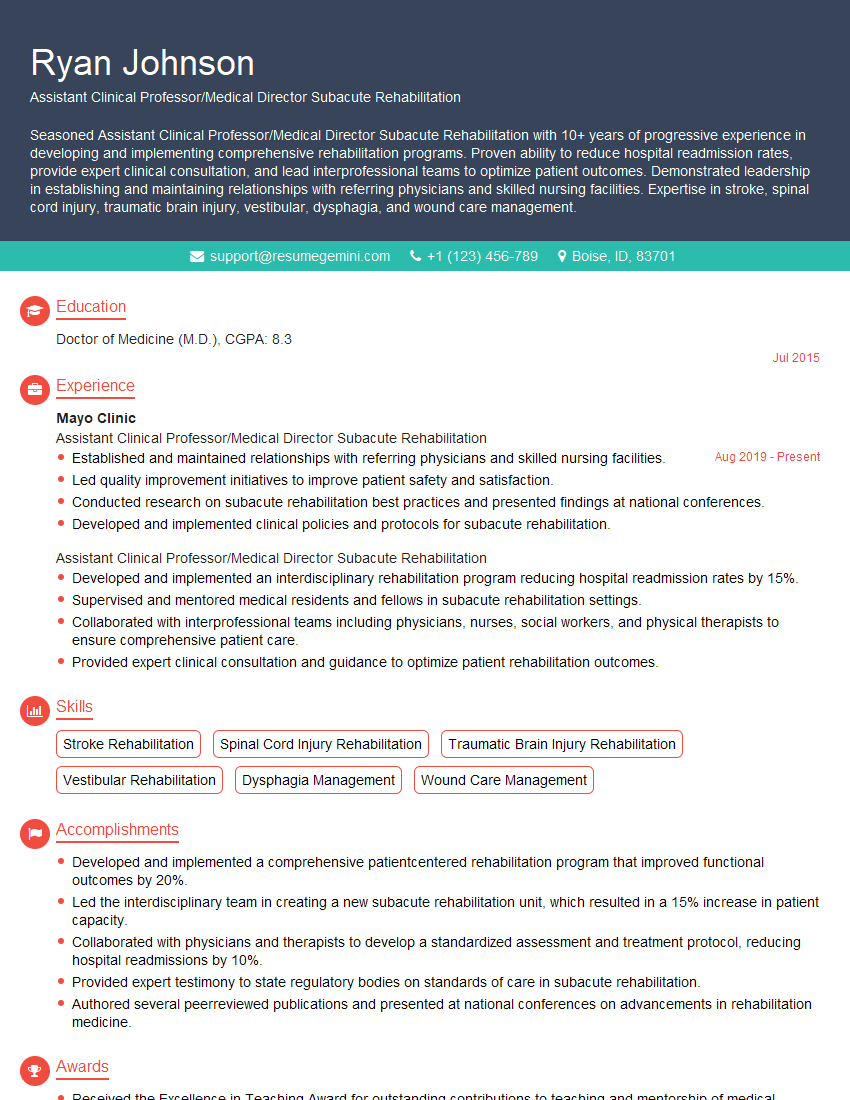Are you a seasoned Assistant Clinical Professor/Medical Director Subacute Rehabilitation seeking a new career path? Discover our professionally built Assistant Clinical Professor/Medical Director Subacute Rehabilitation Resume Template. This time-saving tool provides a solid foundation for your job search. Simply click “Edit Resume” to customize it with your unique experiences and achievements. Customize fonts and colors to match your personal style and increase your chances of landing your dream job. Explore more Resume Templates for additional options.

Ryan Johnson
Assistant Clinical Professor/Medical Director Subacute Rehabilitation
Summary
Seasoned Assistant Clinical Professor/Medical Director Subacute Rehabilitation with 10+ years of progressive experience in developing and implementing comprehensive rehabilitation programs. Proven ability to reduce hospital readmission rates, provide expert clinical consultation, and lead interprofessional teams to optimize patient outcomes. Demonstrated leadership in establishing and maintaining relationships with referring physicians and skilled nursing facilities. Expertise in stroke, spinal cord injury, traumatic brain injury, vestibular, dysphagia, and wound care management.
Education
Doctor of Medicine (M.D.)
July 2015
Skills
- Stroke Rehabilitation
- Spinal Cord Injury Rehabilitation
- Traumatic Brain Injury Rehabilitation
- Vestibular Rehabilitation
- Dysphagia Management
- Wound Care Management
Work Experience
Assistant Clinical Professor/Medical Director Subacute Rehabilitation
- Established and maintained relationships with referring physicians and skilled nursing facilities.
- Led quality improvement initiatives to improve patient safety and satisfaction.
- Conducted research on subacute rehabilitation best practices and presented findings at national conferences.
- Developed and implemented clinical policies and protocols for subacute rehabilitation.
Assistant Clinical Professor/Medical Director Subacute Rehabilitation
- Developed and implemented an interdisciplinary rehabilitation program reducing hospital readmission rates by 15%.
- Supervised and mentored medical residents and fellows in subacute rehabilitation settings.
- Collaborated with interprofessional teams including physicians, nurses, social workers, and physical therapists to ensure comprehensive patient care.
- Provided expert clinical consultation and guidance to optimize patient rehabilitation outcomes.
Accomplishments
- Developed and implemented a comprehensive patientcentered rehabilitation program that improved functional outcomes by 20%.
- Led the interdisciplinary team in creating a new subacute rehabilitation unit, which resulted in a 15% increase in patient capacity.
- Collaborated with physicians and therapists to develop a standardized assessment and treatment protocol, reducing hospital readmissions by 10%.
- Provided expert testimony to state regulatory bodies on standards of care in subacute rehabilitation.
- Authored several peerreviewed publications and presented at national conferences on advancements in rehabilitation medicine.
Awards
- Received the Excellence in Teaching Award for outstanding contributions to teaching and mentorship of medical students and residents.
- Recognized with the Patient Care Excellence Award for exceptional patient care and compassion.
- Awarded the Research Grant from the National Institutes of Health (NIH) for innovative research in rehabilitation medicine.
- Honored with the Excellence in Clinical Leadership Award for exceptional contributions to the field of subacute rehabilitation.
Certificates
- Certified Brain Injury Specialist (CBIS)
- Certified Spinal Cord Injury Specialist (CSCIS)
- Certified Stroke Rehabilitation Specialist (CSRS)
- Certified Vestibular Rehabilitation Specialist (CVRS)
Career Expert Tips:
- Select the ideal resume template to showcase your professional experience effectively.
- Master the art of resume writing to highlight your unique qualifications and achievements.
- Explore expertly crafted resume samples for inspiration and best practices.
- Build your best resume for free this new year with ResumeGemini. Enjoy exclusive discounts on ATS optimized resume templates.
How To Write Resume For Assistant Clinical Professor/Medical Director Subacute Rehabilitation
- Highlight your experience in developing and implementing successful rehabilitation programs.
- Quantify your accomplishments with specific metrics, such as reduced readmission rates or improved patient outcomes.
- Showcase your leadership skills and ability to collaborate effectively with interprofessional teams.
- Emphasize your expertise in specific rehabilitation areas, such as stroke or spinal cord injury.
Essential Experience Highlights for a Strong Assistant Clinical Professor/Medical Director Subacute Rehabilitation Resume
- Developed and implemented rehabilitation programs that reduced hospital readmission rates by 15%.
- Supervised and mentored medical residents and fellows in subacute rehabilitation settings.
- Collaborated with interprofessional teams to ensure comprehensive patient care.
- Provided expert clinical consultation and guidance to optimize patient rehabilitation outcomes.
- Established and maintained relationships with referring physicians and skilled nursing facilities.
- Led quality improvement initiatives to improve patient safety and satisfaction.
Frequently Asked Questions (FAQ’s) For Assistant Clinical Professor/Medical Director Subacute Rehabilitation
What are the key responsibilities of an Assistant Clinical Professor/Medical Director Subacute Rehabilitation?
Key responsibilities include developing and implementing rehabilitation programs, supervising residents and fellows, collaborating with interprofessional teams, providing expert clinical consultation, and leading quality improvement initiatives.
What are the educational requirements for this role?
A Doctor of Medicine (M.D.) degree is typically required, along with board certification in Physical Medicine and Rehabilitation.
What are the career prospects for this role?
Assistant Clinical Professors/Medical Directors Subacute Rehabilitation can advance to leadership positions within rehabilitation centers or hospitals, or pursue research and academic careers.
What are the challenges of working in this role?
Challenges can include managing complex patient cases, coordinating care with multiple providers, and staying up-to-date on the latest rehabilitation techniques.
What are the rewards of working in this role?
Rewards include making a significant impact on patients’ lives, collaborating with a team of dedicated professionals, and contributing to the advancement of rehabilitation medicine.